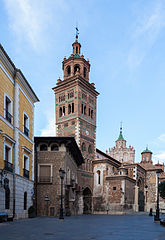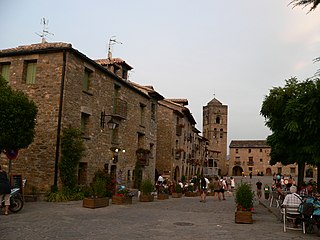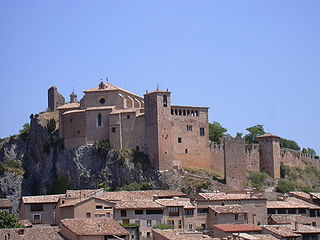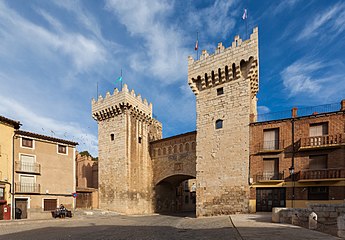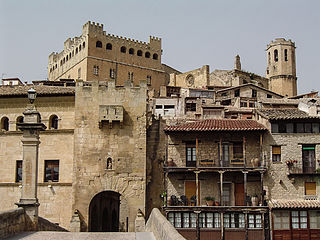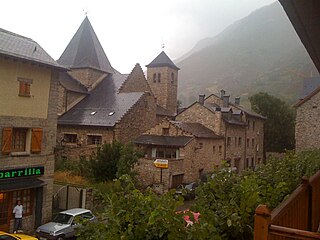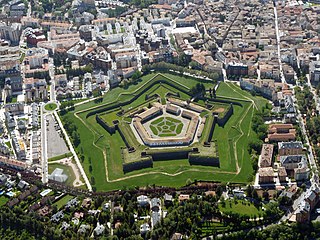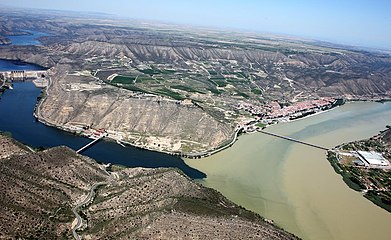Aragon
Aragon
| |
|---|---|
| Anthem:Himno de Aragón(officially) | |
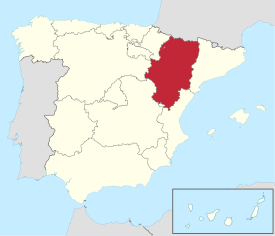 Location of Aragon within Spain | |
| Coordinates:41°00′N1°00′W/ 41.000°N 1.000°W | |
| Country | |
| Capital | Zaragoza |
| Provinces | Huesca,Teruel,andZaragoza |
| Government | |
| •President | Jorge Azcón(PP) |
| • Legislature | Cortes of Aragon |
| Area (9.4% of Spain;ranked 4th) | |
| • Total | 47,720 km2(18,420 sq mi) |
| Population (1 January 2021) | |
| • Total | 1,326,261 |
| • Density | 28/km2(72/sq mi) |
| •Pop. rank | 11th |
| • Percent | 2.82% of Spain |
| Demonym | Aragonese |
| GDP | |
| • Total | €41.762 billion (2022) |
| • Per capita | €31,051 (2022) |
| ISO 3166 code | ES-AR |
| Official languages | Spanish |
| Recognised languages | Aragonese•Catalan[2] |
| Statute of Autonomy | 16 August 1982 18 April 2007 (current version) |
| National day | 23 April |
| Parliament | Cortes of Aragon |
| Congress seats | 13 (of 350) |
| Senate seats | 14 (of 265) |
| HDI(2021) | 0.912[3] very high·5th |
| Website | Gobierno de Aragón |
 | |
Aragon(/ˈærəɡən/ARR-ə-gən,USalso/-ɡɒn,-ɡoʊn/-gon, -gohn;[4]Spanish andAragonese:Aragón[aɾaˈɣon];Catalan:Aragó[əɾəˈɣo]) is anautonomous communityinSpain,coextensive with the medievalKingdom of Aragon.In northeastern Spain, the Aragonese autonomous community comprises threeprovinces(from north to south):Huesca,Zaragoza,andTeruel.Its capital isZaragoza.The currentStatute of Autonomydeclares Aragon ahistoric nationalityof Spain.
Covering an area of47720km2(18420sq mi),[5]the region's terrain ranges diversely from permanent glaciers to verdant valleys, rich pasture lands and orchards, through to the arid steppes of the central lowlands. Aragon is home to many rivers—most notably, the riverEbro,Spain's largest river in volume, which runs west–east across the entire region through the province of Zaragoza. It is also home to thehighest mountainsof thePyrenees.
As of January 2021[update],the population of Aragon was1326261,[6]with slightly over half living in the capital city,Zaragoza.In 2020, the economy of Aragon generated aGDPof€34687million, which represents 3.1% of Spain's national GDP,[7]and is currently 6th in per capita production behind Madrid,Basque Country,Navarre,Cataloniaand La Rioja.[8]
In addition to its three provinces, Aragon is subdivided into 33comarcasor counties. All comarcas of Aragon have a richgeopoliticaland cultural history from itspre-Roman,CelticandRomandays, four centuries of Islamic rule asMarca SuperiorofAl-Andalusor kingdom (ortaifa) ofSaraqusta,as lands that once belonged to the FrankishMarca Hispanica,counties that later formed theKingdom of Aragon,and eventually theCrown of Aragon.
Geography
[edit]Location
[edit]
The area of Aragon is47720km2of which15636km2belong to theprovince of Huesca,17275km2to theprovince of Zaragozaand14810km2to theprovince of Teruel.[5]The total represents a 9.43% of the surface of Spain, being thus the fourth autonomous community in size behind Castile and León, Andalusia, and Castile-La Mancha.
It is located in the northeast of theIberian Peninsula,at a latitude between 39º and 43º'N in thetemperate zone.Its boundaries and borders are in the north withFrance(the regions ofNouvelle-AquitaineandOccitanie), in the west with theautonomous communitiesofCastile-La Mancha(provinces ofGuadalajaraandCuenca),Castile and León(province of Soria),La RiojaandNavarre,and in the east with the autonomous communities ofCatalonia(provinces ofLéridaandTarragona) and theValencian Community(provinces ofCastellónandValencia).
Relief
[edit]The orography of the community has as the central axis theEbro valley(with heights between 150 and 300 meters approx.) which transits between two foothill areas, the Pyrenean and the Iberian, preambles of two mountain formations, thePyreneesto the north and theSistema Ibéricomountain range to the south; the Community has the highest peaks of both mountain ranges, theAnetoand theMoncayorespectively.
Pyrenees
[edit]

The AragonesePyreneesare located in the north of theprovince of Huescaand are arranged longitudinally in three large units: High Pyrenees, Internal Depressions and Outer Ranges.
The Aragonese High Pyrenees contains themaximum heightsof all the Pyrenees mountainous chain. The High Pyrenees is formed in turn by the axial Pyrenees and the Inland Ranges.
In the axial Pyrenees are the oldest materials:granites,quartzites,slatesandlimestonesand the highest peaks like: theAneto(3404m),Maladeta(3309m) and thePerdiguero(3221m). The inner Pre-Pyrenees, composed of more modern rocks (limestones) also has large mountains such asMonte Perdido(3355m),Collarada(2886m) andTendeñera(2853m).

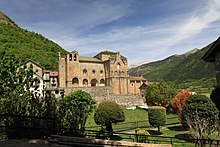
The main Pyrenean valleys are formed by the rivers that are born there, which are:
- Ansó Valley:Veral river
- Hecho Valley:Aragón Subordán river
- Canfranc Valley:Aragón river
- Tena Valley:Gállego river
- Broto Valley:Ara river
- Aínsa Valley:Cinca river
- Pineta Valley:Cinca river
- Gistau Valley:Cinqueta river
- Benasque Valley:Ésera river
The intrapirenaic depression is a broad perpendicular corridor. Its best represented section is theCanal de Berdún,which limits on the south with the reliefs ofSan Juan de la Peña(1552m) andOroel Rock(1769m), modeled on conglomerates of the Campodarbe Formation.

The pre-Pyrenean outer ranges are in the Huescan foothills and constitute the southernmost unit of the Pyrenees; formed by predominantly calcareous materials, reach heights between1500and2000meters. TheSierra de Guara,one of the most important mountain ranges of the SpanishPre-Pyrenees,stands out; its summit, theGuara Peak,reaches2077metres.[9]TheMallos de Riglos,near the town ofAyerbe,stand out for their beauty.
Depression of the Ebro
[edit]The Aragonese central depression includes a wide lowland area, which is also the central part of theDepression of the Ebro.North of the river there is theSierra de Alcubierreranges (811 m) one of the typical limestone plateaus of the valley.
TheEbro Valleyis a tectonic pit filled with sedimentary materials, accumulated in theTertiary agein horizontal series. In the center, fine materials such asclays,plastersandlimestoneswere deposited. To the south of theEbrothere are the limestone plateaus ofBorjaand ofZaragoza.
Sistema Ibérico
[edit]
The Aragonese section of theSistema Ibéricostraddles the provinces ofZaragozaandTeruel.It is a set of hills without a clear structural unit, which can be divided into two zones: Sistema Ibérico del Jalón and Sistema Ibérico turolense. In the first, theMoncayostands out with2314m,formed by Paleozoic quartzites andslates,partly covered by Mesozoiclimestones.The second is formed by elevated terrain (from1000to2000min general), but flattened and massive. To the southwest of the depression the summits of theSierra de Albarracínrange are reached above1800m,southeast the2000mare reached in theSierra de Javalambrerange and finally theSierra de Gúdarrange (2024m) transitions to theMaestrazgoarea in theValencian Community.
Climate and vegetation
[edit]

There are two main types of climate in Aragón, theSemi-arid climateand theOceanic climate.Its irregular orography creates severalmicroclimatesthroughout the entire community. From the High mountainAlpine climateof the centralPyreneesto the north, with perpetual ice (glaciers), to theHumid subtropical climate(which is very common inHuesca's lower altitude areas) to thesteppe or semi-desert zones,such as theMonegros Desert,passing through the intensecontinental climateof the Teruel-Daroca area and theMediterranean climatein the southern areas borderingCastilla La Manchaand theValencian Community.[10]
The main characteristics of the Aragonese climate are:[11]
- Rainfall is mostly low, with much of Aragon placed in abowlof low ground between thePyrenean mountain rangeto the north and theSistema Ibéricomountain range to the south, cut off from maritime air masses. This situation means that the rain falls mainly in the higher areas, and that the temperature range features large contrasts, with cold winters and hot summers, as typical ofcontinental climates.
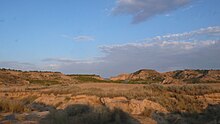
- Rainfall is also irregular, as typical ofMediterranean climates,with randomly alternating dry and wet years.
- The air currents are often encased in themiddle Ebro Valleyfrom northwest to southeast, giving a characteristic wind, thecierzo,which stands out for its intensity and frequency.
Temperatures are very dependent on the altitude. In theEbro Valleythe winters are relatively moderate, although thefrostsare very common and the thermal sensation can decrease a lot with thecierzo.Temperatures in summer can exceed 40 °C in the central areas. In mountain areas winters are long and rigorous, average temperatures can be up to 10 °C lower than in the valley.
The two most important winds of Aragon are thecierzoand thebochornoorlevant.The first is a cold and dry wind that crosses theEbro Valleyfrom northwest to southeast and that can become quite strong. The second is a warm wind, more irregular and smooth, coming from the south-east.
Thevegetationfollows the oscillations of relief and climate. There is a great variety, both in natural vegetation and in crops. In the high areas there are forests (pines, firs, beech trees, oaks), bush and meadows, and in the centralEbro Valley,evergreen oakandjuniperare the most common trees.
Hydrography
[edit]
Most Aragonese rivers are tributaries of theEbroRiver, which is the largest river in Spain and divides the community in two. Of the tributaries of the left bank of the river, the ones originating in the Pyrenees, theAragón Riverstands out. Its headwaters are in Huesca, but it ends at the community of Navarre, theGállegoand theCinca,which joins theSegrejust before emptying into the Ebro at the height ofMequinenza.On the right bank, theJalón,HuervaandGuadalopestand out.
In the stream bed of the Ebro river, near the border with Catalonia, theMequinenza Reservoir,of1530hm3and a length of about 110 km; it is popularly known as the "Sea of Aragon".
The small Pyrenean mountain lakes calledibonesmerit special mention. These lakes are very scenic, originating during the lastglaciation,and are usually found above2000m.
The Autonomous Community lies within three hydrographic regions, the Ebro River, theTagusRiver (which originates in theSierra de Albarracínrange), and theJúcar,which has as its main river in this community theTuria.
Protected spaces
[edit]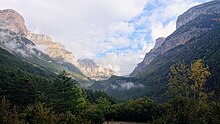
In Aragon, protected natural spaces are managed through theRed Natural de Aragón,an entity created in 2004 to protect all elements withecological,landscape and cultural value and at the same time coordinate and establish common standards that contribute to their conservation and sustainable use. In this entity are integratednational parks,natural parks,nature reserves,biosphere reservesand other protected natural areas that have been declared by the autonomous community, theRamsar Conventionor theNatura 2000.[12]
Within the protected areas is the onlynational parkof Aragon: theOrdesa y Monte Perdido National Park,the second national park created inSpain,in 1918, it is found in thePyreneesin the comarca ofSobrarbe,occupies an area of15608ha,a part of the19679haof the peripheral area of protection. It also enjoys other figures of protection like theBiosphere ReserveofOrdesa-Viñamalaand is cataloged as aWorld Heritage SitebyUNESCO.[13]
In addition there are 4 other natural parks: theMoncayo Natural Parkwith an extension of11144ha,theSierra y Cañones de Guara Natural Parkwith47453haand33286haof peripheral area of protection, thePosets-Maladeta Natural Parkwith33440.6 haand5920.2 haof peripheral area of protection, and theValles Occidentales Natural Parkwith27073haand7335haof peripheral area of protection.
There are also three nature reserves, five natural monuments and three protected landscapes.[14]
Aiguabarreig Segre-Cinca-Ebro
[edit]
At the confluence of theSegreandEbrorivers, the Aiguabarreig Ebro-Segre-Cinca is a space with great natural wealth and a great variety of ecosystems that range from Mediterranean steppes to impenetrable riverside forests, making this space a paradise for biodiversity. Territorially, the Aiguabarreig is at the center of the Middle Depression of the Ebro. It borders to the west with the Monegros, to the east with the Tossals de Montmeneu and Almatret and to the south with the tail of the Ribarroja reservoir. This space is named with Catalan word of origin that designates the place where two or more water streams meet and form one. The Segre and Cinca form a first Aiguabarreig between the towns of La Granja d'Escarp, Massalcoreig and Torrente de Cinca, a few kilometers downstream they converge with the waters of the Ebro, already in the municipality ofMequinenza,forming one of the largest river confluences of the entire Iberian Peninsula.
History
[edit]Aragon, occupying the northeast of theIberian Peninsulahas served as a bridge between theMediterranean Sea,the peninsular center and the coasts of theCantabrian Sea.The human presence in the lands that today form the autonomous community date back several millennia, but present-day Aragon, like many of the current historical nationalities, was formed during theMiddle Ages.
Prehistory
[edit]
The oldest testimonies of human life in the lands that today make up Aragon go back to the time of the glaciations, in thePleistocene,some600000years ago. This population left the Acheulean industry that found its best weapons in thehand axesofflintor thecleaversofquartzite.
In theUpper Palaeolithicappeared two new cultures: Solutrean and Magdalenian.
TheEpipaleolithicwas centered inLower Aragon,occupying the epoch between the 7th and the 5th millennium.
In the first half of the 5th millenniumBCE,Neolithicremains are found in the Huescan Outer Ranges and in Lower Aragon.
TheEneolithicwas characterized in theprovince of Huescapresenting two important megalithic nuclei: thePre-Pyreneesof the Outer Ranges and the High Pyrenean valleys.
The LateBronze Agebegins in Aragon around 1100 BCE with the arrival of theUrnfield culture.They are Indo-European people, with an alleged origin in Central Europe, who incinerate their dead by placing the ashes in a funeral urn. There are examples in the Cave del Moro ofOlvena,the Masada del Ratón inFraga,Palermo and the Cabezo de Monleón inCaspe.
From the metallurgical point of view there seems to be a boom given the increase in foundry molds that are located in the populations.
TheIron Ageis the most important, since throughout the centuries it is the true substratum of the Aragonese historical population.
The arrival of Central Europeans during theBronze AgebyPyreneesuntil reaching the Lower Aragon area, supposed an important ethnic contribution that prepared the way to the invasions of Iron Age.
Ancient history
[edit]
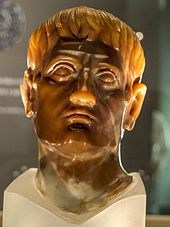
TheMediterraneancontributions represented a commercial activity that will constitute a powerful stimulus for the iron metallurgy, promoting the modernization of the tools and the indigenous armament, replacing the old bronze with the iron. There is presence ofPhoenician,GreekandEtruscanproducts.
In the 6th century BCE there are six groups with different social organization:Vascones,Suessetani,Sedetani,Iacetani,Ilergetesand CiteriorCeltiberians.
They areIberizedgroups with a tendency towards stability, fixing their habitat in durable populations, with dwellings that evolve towards more enduring and stable models. There are many examples in Aragon, among them Cabezo de Monleón inCaspe,Puntal ofFraga,Roquizal del Rullo or Loma de los Brunos.
The type of social organization was based on the family group, consisting of four generations. Self-sufficient societies in which the greater part of the population was dedicated to agricultural and livestock activities. In the Iberian scope the power was monarchical, exercised by a king; there was a democratic assembly with participation of the male population.
There were visible social differentiations and established legal-political statutes.
TheRomansarrived and progressed easily into the interior.
In the territorial distribution that Rome made ofHispania,the current Aragon was included in theHispania Citerior.In the year 197 BCE,Sempronius Tuditanusis the praetor of the Citerior and had to face a general uprising in their territories that ended with the Roman defeat and the own death of Tuditanus. In view of these facts theSenatesent the consulMarcus Porcius Catowith an army of60000men. The indigenous peoples of the area were rebelling, except for theIlergeteswho negotiated peace with Cato.
There were different uprisings of the Iberian peoples against the Romans, in 194 BCE sees a general uprising with elimination of half of the Roman army, in 188 BCEManlius Acidinus Fulvianus,praetor of the Citerior, must confront in Calagurris (Calahorra) with theCeltiberians,in the 184 BCE Terentius Varro did it with theSuessetani,to those who took the capital, Corbio.
In the 1st century BCE Aragon was the scene of thecivil warto seize the power ofRomewhere the governorQuintus Sertoriusmade Osca (Huesca) the capital of all the territories controlled by them.

Already in the 1st century BCE, the today Aragonese territory became part of the provinceTarraconensisand there was the definitive romanization of it creating roads and consolidating ancient Celtiberian and Iberian cities such asCaesaraugusta(Zaragoza), Turiaso (Tarazona), Osca (Huesca) orBilbilis(Calatayud).
In the middle of the 3rd century the decay of theRoman Empirebegan. Between the years 264 and 266 theFranksand theAlemanni,two Germanic peoples who passed through thePyreneesand came toTarazona,which they sacked. In the agony of the Empire groups of bandits emerged who were dedicated to pillage. TheEbro Valleywas ravaged in the 5th century by several gangs of evildoers calledBagaudae.
Middle Ages
[edit]
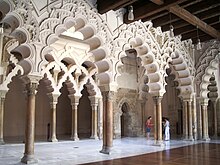
After the disintegration of theWestern Roman Empire,the current area of Aragon was occupied by theVisigoths,forming theVisigothic Kingdom.
In the year 714muslimsfrom North Africa conquered the central area of Aragon, converting toIslamthe ancient Roman cities such asSaraqusta(Zaragoza) or Wasqa (Huesca). It was at this time that an importantMuwalladfamily arose, theBanu Qasi(بنو قاسي), their domains were located in theEbro Valleybetween the 8th and 10th centuries. After the disappearance of theCaliphate of Córdobaat the beginning of the 11th century, theTaifa of Zaragozaarose, one of the most importantTaifasofAl-Andalus,leaving a great artistic, cultural and philosophical legacy.
The name of Aragon is documented for the first time during theEarly Middle Agesin the year 828, when the smallCounty of AragonofFrankishorigin, would emerge between the rivers that bear its name, theAragón river,and its brother theAragón Subordán river.


That County of Aragon would be linked to theKingdom of Pamplonauntil 1035, and under its wing it would grow to form a dowry ofGarcía Sánchez III of Pamplonauntil the death of the kingSancho "the Great",in a period characterized by Muslim hegemony over almost the entire Iberian Peninsula. During the reign ofRamiro I of Aragonthe borders would be extended following the annexation of the counties ofSobrarbeandRibagorza(year 1044), after having incorporated the populations of the historical comarca ofCinco Villas.
In 1076, on the death ofSancho IV of Pamplona,Aragon incorporated part of the Navarrese kingdom into its territories while Castile did the same with the western area of the former domains of Sancho "the Great". During the reigns ofSancho RamírezandPeter I of Aragon and Pamplona,the kingdom extended its borders to the south, established threatening fortresses in the capital of Zaragoza inEl CastellarandJusliboland tookHuesca,which became the new capital.
The reign ofAlfonso I of Aragonsaw the conquering of the lowlands of the middle Ebro Valley for Aragon:Ejea de los Caballeros,Valtierra,Calatayud,TudelaandZaragoza,the capital of theTaifa of Saraqusta.Upon his death the nobles would choose his brotherRamiro II of Aragon,who left his religious life to assume the royal scepter and perpetuate the dynasty, which he achieved with the dynastic union of theHouse of Aragonwith the owner of theCounty of Barcelonain 1137, year in which the union of both patrimonies would give rise to theCrown of Aragonand would add the forces that would make the conquests of theKingdom of Majorcaand theKingdom of Valenciapossible. The Crown of Aragon would become the hegemonic power of the Mediterranean, controlling territories as important asSicily,Corsica,SardiniaorNaples.
The monarch was known as King of Aragon and also held the titles ofKing of Valencia,King of Majorca(for a time),Count of Barcelona,Lord of Montpellier,and (temporarily)Duke of AthensandNeopatria.Each of these titles gave him sovereignty over the specific region, and the titles changed as territories were lost and won.
According toAragonese law,the monarch had to swear allegiance to the kingdom's laws before being accepted as king. Like other Pyrenean and Basque realms, the Aragonese justice and decision-making system was based on Pyreneanconsuetudinary law,the King was consideredprimus inter pares('first among equals') within the nobility. A nobleman with the title "Chustizia d'Aragón"[15]acted as ombudsman and was responsible for ensuring that the King obeyed the Aragonese laws. An old saying goes, "en Aragón antes de Rey hubo Ley" ( "in Aragon Law came before King" ), similar to the saying in Navarre, "antes fueron Leyes que Reyes", with much the same meaning.
The subsequent legend made theAragonese monarchyeligible and created a phrase for the coronation of the king that would be perpetuated for centuries:
We, who are worth as much as you we make you our King and Lord, as long as you keep ourfuerosand liberties, and if not, not.
— TheChustizia d'Aragón

This situation would be repeated in the Commitment of Caspe (1412), which avoids a war that had dismembered theCrown of Aragonwhen a good handful of aspirants to the throne emerged after the death ofMartin of Aragona year after the death of his first-born,Martin I of Sicily.Ferdinand I of Aragonis the chosen one, of the CastilianHouse of Trastámara,but also directly connected with the Aragonese kingPeter IV of Aragon,through his mother Eleanor of Aragon.
Aragon was already a large-scale political entity: the Crown, theCortes,theDeputation of the Kingdomand theForal Lawconstituted its nature and its character. The marriage ofFerdinand II of AragonwithIsabella I of Castile,celebrated in 1469 inValladolid,derived later in the union of the crowns of Aragon and Castile, creating the basis of theModern State.
Early Modern Age c. 1500–1789
[edit]TheEarly Modern Agewas marked by increasing tension between the power of theSpanish Monarchyand those of the regions. The appointment of a Castilian as Viceroy in 1590, contrary to the agreement all Royal officials be Aragonese caused widespread unrest; when the Madrid authorities attempted to arrest the Aragonese writer and politician Antonio Perez in May 1591, it caused street violence in Zaragossa and a revolt known as the Alterations of Aragon.[16]The unrest was largely confined to Zaragossa and quickly suppressed, with Perez going into exile. Philip then ordered a reduction in the proportion of taxes retained by the Generality of Aragon to lessen their capacity to raise an army against him.[17]

The decay of independent institutions meant political activity focused instead on the preservation of Aragonese history, culture and art. The Archive of the Kingdom of Aragon preserved legal documents and records from the Justiciar and thePalace of Deputationor Parliament, largely destroyed by the French in the battles of 1809. Debates on the causes of the 1590/91 revolt became a contest between opposing views of history that arguably persist in modern Spain.
The new emphasis on Aragonese history led to the creation of the position of Chronicler or Historian of Aragon; its holders includedJerónimo Zurita y Castro,the De Argensola brothers,BartoloméandLupercio,Juan Costa and Jerónimo Martel. Much of the work produced by Aragonese writers challenged Philip II's version of events and were censored by the central government. In retaliation, the Generality of Aragon ordered the work of Castilian historianAntonio de Herrera y Tordesillasto be burned and commissioned Vicencio Blasco de Lanuza to write an alternative. His 'History of Aragon' was published in two volumes, 1616 and 1619 respectively; the urgency shows the importance placed on responding to Herrera. Other works commissioned at this time for the same purpose include aHistory of the Aragonese Deputationby Lorenzo Ibáñez de Aoiz and a detailed cartography of the Kingdom of Aragon by João Baptista Lavanha.
In 1590/91, the Spanish monarchy was at the height of its strength but during the 17th century Spanish power declined for a number of reasons.[18]Famine, disease and almost continuous warfare, largely in the Spanish Netherlands drained money, energy and men and weakened the economy; it is estimated the population of Spain fell nearly 25% between 1600 and 1700.
War and economic decline inevitably led to increases in taxes, with predictable results; the refusal of the CatalanCortesto contribute their share of the 1626Union of Armseventually led to a full-scale revolt in 1640.[19]While Aragon itself remained relatively peaceful, it had to be treated with care by the Madrid government; during the reign ofCharles IIfrom 1665 to 1700, it provided his half-brotherJohn of Austriawith a power base in his battle for control of government with the Queen RegentMariana of Austria.
During the 1701–1714War of the Spanish Succession,Aragon, Catalonia, Valencia and Majorca supported the Austrian claimantCharles.The victory ofPhilip Vaccelerated the trend towards greater centralisation; theNueva Plantadecrees of 1707 abolished thefuerosand Aragonese political structures with their powers transferred to the Deputation of the Kingdom in Madrid; Aragon and Valencia were brought into the system in 1712, Catalonia and Majorca following in 1767.[20]
1790–1936
[edit]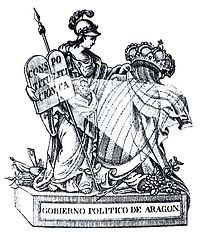
The French invasion of 1808 that madeJoseph BonaparteKing led to the outbreak of theGuerra de la Independencia Españolaor War of Independence in May. Zaragoza was largely destroyed in February 1809 during theSecond Siege of Zaragoza,bringing a halt to its economic development. The 1812 Constitution proposed a number of reforms, including the creation of provincial territories and dividing Aragon into the four provinces ofCalatayud,Teruel,SoriaandGuadalajara.However, these reforms were delayed byFerdinand VII's refusal to accept the constitution and finally implemented in 1822 during the 1820–23Trienio Liberal.When Ferdinand was restored by French Bourbon forces in 1823, he abolished the Constitution along with the provincial reforms. When he died in 1833, theprovincial division of 1833divided Aragon into its current three provinces.

Throughout the 19th century, Aragon was a stronghold of theCarlists,who offered to restore thefuerosand other rights associated with the formerKingdom of Aragon.This period saw a massive exodus from the countryside into the larger cities of Aragon such asHuesca,Zaragoza,TeruelorCalatayudand other nearby regions, such asCataloniaorMadrid.
The history of Aragon in the first half of the 20th century was similar to that of the rest of Spain; the building of infrastructure and reforms made byMiguel Primo de Riveraled to a brief economic boom, with new civil and individual liberties during theSecond Spanish Republic.In June 1936, a draft Statute of Autonomy of Aragon was presented to theCortes Generalesbut the outbreak of theSpanish Civil Warprevented the development of this autonomist project.
Spanish Civil War 1936-1939
[edit]During the1936–1939 Civil War,Aragon was divided between both sides. The eastern area closer to Catalonia was run by the RepublicanRegional Defence Council of Aragon,while the larger western area was controlled by theNationalists.Some of the most important battles of the war were fought in or near Aragon, includingBelchite,TeruelandEbro.After the defeat of theRepublicin April 1939, Aragon and the rest of Spain was governed by theFrancoist dictatorship.
Aragon was a stronghold for theSpanish Revolution,which was a workers'social revolutionthat began at the outbreak of theSpanish Civil Warin 1936 and for two to three years resulted in the widespread implementation ofanarchistand, more broadly,libertarian socialistorganizational principles throughout various portions of the country.
In Aragon, agrarian collectives were formed that were structured by work groups of between five and ten members. To each work group, the community assigned a piece of land for which it was responsible. Each group elected a delegate who represented their views at community meetings. A management committee was responsible for the day-to-day running of the community. This committee was in charge of obtaining materials, carrying out exchanges with other areas, organizing the distribution of production, and the public works that were necessary. Its members were elected in general assemblies in which all the people who made up the community participated.
Even during the second phase of the revolution when some revolutionary structures were subordinated to the government, giving rise to the dissolution or beginning of absorption, appropriation, and intervention of the revolutionary structures by the republican state government, Aragon remained a stronghold of anarcho-syndicalist labor.
1939 - Present
[edit]
Especially during the 1960s, there were large migrations, with a depopulation of the rural areas, towards the industrial areas like the provincial capitals, other areas of Spain, and other European countries. In 1964, one of the so-called Development Poles was created inZaragoza.
In the 1970s, the old town ofMequinenzawas demolished almost completely due to the construction of theRibarroja reservoir.The inhabitants of Mequinenza had to leave their homes to move to the new town on the banks of the River Segre. Some left for more industrial areas such as Barcelona or Zaragoza or even abroad to continue working in mining industries. By the end of 1974 all of the population had already abandoned the Old Town of Mequinenza and was living in the new town.
In the 1970s a period of transition as in the rest of the country was experienced, after the extinction of the previous regime, with the recovery of democratic normality and the creation of a new constitutional framework.
It began to demand an own political autonomy, for the Aragonese historical territory; sentiment that was reflected in the historic manifestation of April 23, 1978 that brought together more than100000aragoneses through the streets ofZaragoza.
Not having plebiscited, in the past, affirmatively a draft Statute of autonomy (second transitory provision of the constitution) and not making use of the difficult access to autonomy by Article 151 whose aggravated procedure required, apart from the initiative of the process autonomic follow the steps of article 143, which was ratified by three quarters of the municipalities of each of the affected provinces that represent at least the majority of the electoral census, and that this initiative was approved by referendum by the affirmative vote of the majority absolute of the electors of each province, Aragon acceded to the self-government by the slow way of article 143 obtaining lower competence top, and less self-management of resources, during more than 20 years.
On August 10, 1982, Aragon's autonomy statute was approved by theCortes Generales,signed by the thenpresident of the Government,Leopoldo Calvo-Sotelo, andsanctionedby His MajestyJuan Carlos I of Spain.
On May 7, 1992, a Special Commission of theAragonese Corts,elaborated a reformed text that was approved by the Aragonese Corts and by the Spanish Cortes. Again, a small statutory reform in the year 1996 extended the competence framework, forcing a definitive comprehensive review for several years, a new statutory text was approved in 2007, by majority but without reaching total unanimity.
In the 1990s the Aragonese society increases a significant qualitative step in the quality of life due to the economic progress of the State at all levels.
At the beginning of the 21st century, a significant increase in infrastructures was established, such as the arrival of the High Speed Train (AVE), the construction of thenew dual carriageway Somport-Saguntoand the promotion of the two airports in the Autonomous Community,ZaragozaandHuesca-Pirineos.At the same time, large technological projects are being undertaken, such as theWalqa Technology Parkand the implementation of a telematic network throughout the community.

In 2007 theStatute of Autonomy of Aragonwas reformed again -which was approved by a broad consensus in the Aragonese Corts, having the support of thePSOE,thePP,thePARand theIU,whereasCHAabstained- granting the Autonomous Community the recognition ofhistorical nationality(since the Organic Law of 1996 reform of the statute, it had the condition ofnationality[21]), includes a new title on the Administration of Chustizia and another on the rights and duties of the Aragoneses and guiding principles of public policies, the possibility of creating an own tax agency in collaboration with that of the State, and also the obligation to public authorities to ensure to avoid transfers from watersheds such astransfer of the Ebro,among many other modifications of the Statute of Autonomy.
The designation ofZaragozaas the venue for the2008 International Exhibition,whose thematic axis wasWaterandSustainable development,represented a series of changes and accelerated growth for theautonomous community.In addition, two anniversaries were celebrated that same year, the bicentennial ofSieges of Zaragozaof theWar of Independenceagainst theNapoleonicinvasion, occurred in 1808 and the centenary of theHispano-French Exposition of 1908that it supposed as a modern event, to demonstrate the cultural and economic thrust of Aragon and at the same time serve to strengthen ties and staunch wounds with theFrenchneighbors after the events of theNapoleonic Warsof the previous century.
Demographics
[edit]Population
[edit]| Year | Pop. | ±% |
|---|---|---|
| 1787 | 623,055 | — |
| 1857 | 880,643 | +41.3% |
| 1900 | 912,711 | +3.6% |
| 1910 | 952,743 | +4.4% |
| 1920 | 997,154 | +4.7% |
| 1930 | 1,031,559 | +3.5% |
| 1940 | 1,058,806 | +2.6% |
| 1950 | 1,094,002 | +3.3% |
| 1960 | 1,105,498 | +1.1% |
| 1970 | 1,152,708 | +4.3% |
| 1981 | 1,213,099 | +5.2% |
| 1991 | 1,221,546 | +0.7% |
| 2001 | 1,204,215 | −1.4% |
| 2011 | 1,344,509 | +11.7% |
| 2021 | 1,331,938 | −0.9% |
| Source:INE | ||
As of 2015[update],half of Aragon's population, 50.45%, live in the capital city ofZaragoza.Huescais the only other city in the region with a population greater than50000.
The majority of Aragonese citizens, 71.8%, live in the province of Zaragoza. 17.1% live in the province of Huesca, and 11.1% in the province of Teruel.[22]The population density of the region is the second lowest in Spain afterCastilla-La Mancha:only 26.8/km2.The most densely populated areas are around the valley of the riverEbro,particularly around Zaragoza, and in the Pyrenean foothills, while the areas with the fewest inhabitants tend to be those that are higher up in the Pyrenean mountains, and in most of the southern province of Teruel.
Only four cities have a population of more than20000:Zaragoza700000,Huesca50000,Teruel35000,andCalatayud20000.
Languages
[edit]
Spanishis the native language in most of Aragon, and it is the only official language, understood and spoken by virtually everyone in the region. In addition to it, theAragonese languagecontinues to be spoken in several local varieties in the mountainous northern counties of thePyrenees,particularly in westernRibagorza,Sobrarbe,JacetaniaandSomontano;it is enjoying a resurgence of popularity as a tool for regional identity. In the easternmost areas of Aragon, along the border withCatalonia,varieties of theCatalan languageare spoken, including the comarcas of eastern Ribagorza,La Litera,Bajo Cinca,Bajo Aragón-Caspe,Bajo AragónandMatarraña.The strip-shaped Catalan-speaking area in Aragon is often calledLa Franja.
The Declaration of Mequinenza (Declaració de Mequinensa in Catalan) was a document signed on February 1, 1984, inMequinenzaby the mayors of 17 municipalities of the Aragonese Catalan-speaking area together with José Bada Paniello (Minister of Culture of Government of Aragon at the time). Following the declaration, and complying with one of the proposals contained therein, on October 1, 1985, an agreement between the Government of Aragon and the Ministry of Education and Science was implemented for the teaching of the Catalan language as a voluntary and assessable subject in schools in the area.
TheLanguages Acts of Aragonof 2009 and 2013 have been passed to try to regulate the languages in this autonomous community. An update of these laws was announced but as of 2019 it has not been carried out.
Territorial division
[edit]Aragon is divided into three provinces from north to south, named after their capitals:Huesca,ZaragozaandTeruel.The provinces are further divided into 33comarcas,three of which are in more than one province. There are a total of 732municipalitiesin the region.
Culture
[edit]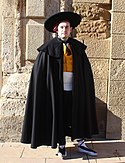
Some medieval monuments of Teruel and Zaragoza are protected byUNESCOas part of theWorld Heritage SitesMudéjar Architecture of Aragon.
The traditional dance of Aragon is known asjotaand is one of the faster Spanish dances. It is also the most widespread in Aragon and the exact style and music depend on the area.
There are other less popular dances named "paloteaos" similar to the sword/stick dances of other regions.
The music to one local dance, "The Dance of Majordomos" ofBenasque,was so enjoyed byRafael del Riegoon a visit to the town that he ordered it to be copied resulting in the "Hymn of Riego".
Typical Aragonese instruments include the stringed drum or "Chicotén", bagpipes such as the "gaita de boto", oboes such as the "Dulzaina", and small flutes like the "Chiflo". Some instruments have been lost, such as the "trompa de Ribagorza", although there have been efforts to reconstruct them. In contrast to other Pyrenean regions, the "Chicotén" and "Chiflo" never have stopped being played.[23]
The Carnival of Bielsa[24](Huesca) has ancient origins and includes a group of men carrying long sticks, wearing skirts, cowbells and boucard/goat-like horns and skins with black-painted faces called "Trangas" symbolising "virility" who surround another man wearing skins playing the part of a bear called "l'onso". In Aragonese mythology the bear carried souls between the world of the living and the world of the dead. Trangas dance with young females named "madamas" symbolising "purity" and wearing colourful dresses. Other traditional figures include a horse rider named "Caballé".
Cuisine
[edit]
With its lush Pyrenean pastures, lamb, beef, and dairy products are, not surprisingly, predominant inAragonese cuisine.Also of note is its ham fromTeruel;olive oil fromEmpeltreandArbequina;longanizafromGraus;rainbow trout and salmon, boar,trufflesand wild mushrooms from the upper river valleys of theJacetania,Gallego,Sobrarbe,andRibagorzaregions; and wines fromCariñena,Somontano,Calatayud,andCampo de Borja;and fruit, especially peaches, from its fertile lower valleys. The region also features a unique localhaggis,known aschireta,several interesting seafood dishes, including various crab pastes, which developed from an old superstition that crabs help prevent illness, and sweets such as "Adoquines del Pilar" and "Frutas de Aragón". There are also other sweets like "Tortas de alma" fromTerueland "Trenza de Almudevar"or" Castañas de Huesca "fromHuesca.
Research
[edit]
TheUniversity of Zaragozais the largest university in Aragon, which conduct research in various disciplines. Of the Nationally recognizedUnique Scientific and Technical Infrastructureresearch institutes, Aragon hosts the following:
- Astrophysical Observatory of Javalambre(OAJ), which is located in theJavalambre mountain range,south of the Teruel province. OAJ is managed by theCenter for Physics Studies of the Cosmos of Aragon(CEFCA), which is located in theTeruelcity.
- Canfranc Underground Laboratory,located in the north of the Huesca province and is managed by a consortium of the Aragon and national governments and the University of Zaragoza.
Economy
[edit]Aragon is among the richest autonomous regions in Spain, with GDP per capita above the nation's average. TheGross domestic product(GDP) of the autonomous community was 37.0 billion euros in 2018, accounting for 3.1% of Spanish economic output. GDP per capita adjusted for purchasing power was 30,200 euros or 100% of the EU27 average in the same year. The GDP per employee was 101% of the EU average.[25]
The traditional agriculture-based economy from the mid-20th century has been greatly transformed in the past several decades and now service and industrial sectors are the backbone of the economy in the region.
The well-developed irrigation system around the Ebro has greatly supported the productive agriculture. The most important crops includewheat,barley,rye,fruit andgrapes.Livestock-breeding is essential especially in the northern areas, where the lush meadows provide excellent conditions for sheep and cattle. As of November 2020 the regional livestock includes 8.8 million pigs (around six pigs per person), and, as of January 2021, 73.1 milliongallifowls.[26]Also as of November 2020, there were more than 1.6 million sheep and about 50,000 goats,[27]as well as about 400,000 head of cattle, most of them in Huesca province.[28]According toGreenpeace,30% of the Aragonese territory is endangered byliquid manurefromintensive farming,puttingaquifersand other water reserves at risk.[29]
The chief industrial centre is the capital Zaragoza, where the largest factories are located. The largest plant is theOpelautomotive plant with8730employees and production of200000per year. It supports many related industries in the area. Other large plants in the city include factories for trains and household appliances. Mining ofironore andcoalis developed to the south, near Ojos Negros. Electricity production is concentrated to the north where numerous hydro power plants are located along the Pyrenean rivers and in the1150MWTeruel Power Plant.There is an aluminium refinery in the town of Sabiñánigo. The main centres of electronics industry are Zaragoza,HuescaandBenabarre.Chemical industry is developed in Zaragoza, Sabiñánigo,Monzón,Teruel, Ojos Negros,Fraga,Benabarre and others.
The transport infrastructure has been greatly improved. There are more than[data missing]ofmotorwayswhich run from Zaragoza toMadrid,Teruel, Basque country, Huesca andBarcelona.The condition of the other roads is also good. As of 2016[update]there are899008cars in Aragon.[5]Through the territory of the province runs the new high-speed railway between Madrid and Barcelona with siding from Zaragoza to Huesca, which is going to be continued to theFrenchborder. There is an InternationalAirport at Zaragoza,as well as several smaller airports atHuesca,Caudé, Santa Cilia de Jaca and Villanueva de Gállego.
The unemployment rate stood at 11.6% in 2017 and was lower than the national average.[30]
| Year | 2006 | 2007 | 2008 | 2009 | 2010 | 2011 | 2012 | 2013 | 2014 | 2015 | 2016 | 2017 |
|---|---|---|---|---|---|---|---|---|---|---|---|---|
| Unemployment rate (in %) |
5.5 | 5.3 | 7.3 | 13.1 | 15.0 | 17.1 | 18.7 | 21.4 | 20.2 | 16.3 | 14.7 | 11.6 |
Government and politics
[edit]Current political organization
[edit]As anautonomous communityof Spain, Aragon has an electedregional parliament(Spanish:Cortes de Aragón,Aragonese:Cortz d'Aragón,Catalan:Corts d'Aragó) with 67 seats. It meets in theAljafería,a Moorish palace in the capital city,Zaragoza.The Parliament chooses aPresident for theDiputación General de Aragónor Aragon Government, for a four-year term. The current president (since July 2015) isJavier Lambánof thePSOE.Nationally, Aragon elects 13 Deputies and 14 Senators to theCortes Generales.
In addition to the Spanish political parties, there are a number of Aragonese parties, such as theChunta Aragonesista,a left-wing Aragonese nationalist party, and theAragonese Party,more conservative. Chunta Aragonesista had a seat in Spain's nationalCongress of Deputiesfrom 2000 to 2008, while the centrist Aragonese Party has three national senators, who are in coalition with the ruling People's Party.[31]
In a 2011 regional government survey, 47.6% of the population wanted greater autonomy for Aragon, while 35.2% were satisfied with its current level of autonomy. A total of 6% wanted an end to autonomy and 3.2% wanted full independence.[32]
Historic
[edit]Aragon in the Middle Ages was the hub of the widerCrown of Aragon.The Crown was represented in the region from 1517 by aviceroy.
In 1479, KingFerdinand II of AragonmarriedIsabella I of Castile,a kingdom covering much of the rest of modern Spain. However, until theNueva Planta decreesof 1707, Aragon maintained its own separate laws and institutions.
Media
[edit]Aragon has media set-ups in television, radio and numerous newspapers.
Television
[edit]On 21 April 2006, regional television broadcasts in Aragon officially began with the launch ofAragón TV.The law which established the CARTV (Aragon Corporation Radio and Television) dated from 1987, but various political disputes delayed the project for several legislatures.
During the years that Aragon had no public television, several media groups sought to supplement their absence. For one TVE-Aragon, taking the Territorial Centre in Zaragoza, produced several programs and educational activities with the Aragonese town. As for private groups, there were several projects. The most widely accepted for many years had been Antena Aragón, which came to be regarded as regional television. This channel was created in 1998 and disappeared in 2005 shortly after having to leave the Media Production Centre (CPA), as this was built by the DGA for future public television host Aragon. With the push for the creation of public television, Antena Aragón merged with RTVA (Radio Television Aragonesa) belonging to the Herald Group. Merging RTVA Antena Aragón and led to channel ZTV (Zaragoza Television). Moreover, Antena 3 Televisión aired for several years, and off to Aragon, a news report fully Aragonese, having a central issue in the Pinares de Venecia in Zaragoza, within the premises of the Theme Park of Zaragoza.
Aragón TV was launched in 2006 after spending a season broadcasting a letter and a loop with images of Aragonese villages and audio of regional radio programs.
Radio
[edit]Aragon Radio, began broadcasting on 18 August 2005 at 5 p.m. with the sound of drums and drums of Calanda and a group song Zaragoza "The Fish". Estimates of its audience range from 20 000 listeners, according to the latest EMG, to70000,according to private findings. The channel has regional news bulletins every hour from 7 a.m. to midnight and coverage of sports.
Sport
[edit]
Aragon's most successful football club isReal Zaragoza.The club was founded in 1932 and spent 58 seasons in First Division, having played at its current ground,La Romareda,since 1957. Real Zaragoza have won sixCopa del Reytitles from 1964 to 2004,[33]and the1995 European Cup Winners' Cup. The other most important football team in Aragon isSD Huesca,that in 2018 and 2020 was able to promote tofirst division.Now, SD Huesca is still playing insecond divisionafter being relegated two times.CD Teruelwas able to promote in the 2022/2023 season fromsegunda federación(Spanish 4th division) toprimera federación(Spanish 3rd division) There are plenty of smaller clubs in the region playing in semi-professional and amateur competitions.
Skiingis popular in the Pyrenean north of Aragon, at resorts such asFormigalandCandanchú.[34]The Aragonese city ofJacain the Pyrenees bid to host theWinter Olympicsfrom 2002 to 2014.[35]Zaragozawas considering a bid for the2022 Winter Olympics,[36][37]but dropped it in 2011 to strengthen the chance ofBarcelonawinning the games.[38]
TheCiudad del Motor de Aragón,also known as Motorland Aragón, is amotorsportrace tracklocated nearAlcañizin Aragon. It is home to theAragon motorcycle Grand Prix.
Notable people from Aragon
[edit]Up to the 19th century
[edit]- SaintElizabeth of Portugal(1271–1336), queen consort ofPortugaland a saint of the Roman Catholic Church
- Antipope Benedict XIII(1328–1423), known asPapa Luna,Avignon pope and art patron-sponsor
- KingFerdinand II of Aragon(1452–1516), married queenIsabella I of Castileand united theCrown of Aragonwith theCrown of Castile,giving form to the actualSpain
- Michael Servetus(1509/11–1552), theologian and physician who received numerous charges of heresy by both Catholics and Protestants and was burnt at the stake inCalvin'sGenevaduring the 16th century
- Joseph Calasanz(1557–1648),Catholic priestwho dedicated himself to the education of poor boys atRomeand founded a society pledged to that work
- Baltasar Gracián(1601–1658), writer of Spanish Baroque literature
- Pablo Bruna(1611–1679), blind composer, organist
- Gaspar Sanz(1640–1710), composer, guitarist and organist
- Rocque Joaquin de Alcubierre(1702–1780), military engineer who discovered the ruins ofPompeii
- Francisco Garcés(1738–1781),missionarypriesttoNorth Americawho founded two pueblo missions[39]
- Francisco de Goya(1746–1828) 18th-century painter.
20th and 21st centuries
[edit]- Eva Amaral Lallana,singer-songwriter and member of the rock band Amaral
- Enrique Bunbury(Enrique Ortiz de Landázuri Izarduy), rock singer-songwriter forHéroes del Silencioand Enrique Bunbury Band
- Luis Buñuel Portolés,filmmaker
- St. Josemaría Escrivá de Balaguer y Albás,Spanish Catholic priest, founder ofOpus Dei
- Pablo Gargallo Catalán,sculptor and painter
- Jesús Moncada Estruga,writer
- Ramon J. Sender Garcés,writer
- José Antonio Labordeta Subías,singer, writer, politician (deputy) and TV presenter
- Santiago Ramón y Cajal,Nobel Prize in Physiology or Medicinerecipient for his research on the human brain and nervous system
- Carlos Saura Atarés,filmmaker
- Pablo Serrano Aguilar,sculptor
- Alberto Zapater Arjol,footballer
- María Pilar León Cebrián,footballer
- Teresa Perales Fernández,Paralympic swimmer, politician and university professor
- Fernando Simón Soria,epidemiologist and director of theCoordination Centre for Health Alerts and Emergenciesof theSpanish Ministry of Healthduring theebolaandCOVID-19outbreaks
- Federico Jiménez Losantos,radio presenter and right wing pundit
- Sheila Herrero Lapuente,inline speed skater
- Antón García Abril,music composer
- Soledad Puértolas Villanueva,writer, member of theRoyal Spanish Academyand winner of thePremio Planeta de Novela
- Juan Alberto Belloch Julbe,judge, former SpanishMinister of Justiceand ofJustice and Interior,former mayor ofZaragoza,formerdeputyandsenatorand former member of theGeneral Council of the Judiciary
- Luisa Fernanda Rudi Úbeda,senator, former and first femalePresident of the Congress of the Deputies,former and first femalePresident of Aragon,former and first female mayor of Zaragoza, former deputy,MEPandautonomic deputyand former president of theAragonese People's Party
- Marcelino Iglesias Ricou,former President of Aragon, former senator and autonomic deputy and former secretary-general of theSocialists' Party of Aragonand former member of the executive committee of thePSOE
- Román Escolano Olivares,economist, former SpanishMinister of Economy,Industryand Competitiveness and former vice-president of theEuropean Investment Bank
- Miki (Miguel) Nadal Furriel,comedian, actor and TV presenter
- Luisa Gavasa Moragón,actress
- Hana Jalloul Muro,university professor, politician andSecretary of State of Migrations
- Guitarricadelafuente(Álvaro Lafuente Calvo), singer-songwriter, guitarist and musician
- Ara Malikian,violinist
- Ana Santos Aramburo,librarian and director of theNational Library of Spain
- José Luis Gil Sanz,television, cinema, theatre and voice actor
- Alexandra Jiménez Arrechea,actress and TV presenter
- Conchita Martínez Bernat,tennis player
- Pilar Palomero,film director and screenwriter
- Paco Martínez Soria,actor and theatre entrepreneur
- Miguel Ángel Tirado Vinués(also known as "Marianico el Corto" ), comedian and actor
- Violadores del Verso,rap music crew
- Álvaro Arbeloa Coca,footballer
- Juan Antonio San Epifanio Ruiz(most commonly known as "Epi" ), basketball player
- Manuel Pizarro Moreno,economist, jurist and former politician (deputy)
Symbols
[edit]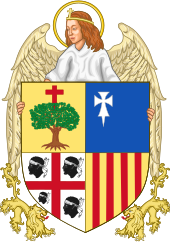
The currentcoat of armsof Aragon is composed of the four barracks and is attested for the first time in 1499, consolidating since theEarly Modern Agesto take root decisively in the 19th century and be approved, according to precept, by theReal Academia de la Historiain 1921.
Thefirst quarteringappears at the end of the 15th century and commemorates, according to traditional interpretation, the legendarykingdom of Sobrarbe;in the second quarter there is the so-called "Cross of Íñigo Arista",innovation ofPeter IV of Aragon(from an anachronistic interpretation of the cross that symbolized the religion of the Asturian, Navarrese and Aragonese Christian kings), who took it as shields of the ancient kings of Aragon, although historically there were no heraldic emblems in the peninsula (or "signal shields", as it was said in the Middle Ages) before the union dynastic of 1137 of theHouse of Aragonwith theHouse of Barcelona;in the third quartering appears theSaint George's Crossescutcheoned of four heads of Moors (the call "Cross of Alcoraz"), that is witnessed for the first time in a seal of 1281 ofPeter III of Aragonand would remember, according to tradition arising from the 14th century, the battle in whichPeter I of Aragon and Pamplonaand the futureAlfonso I of Aragontook Huesca and was considered in theEarly modern Agesone of the proprietary emblems of thekingdom of Aragon;and in the fourth is the emblem of the so-called "bars of Aragon"orRoyal Sign of Aragon,the oldest of the heraldic emblems that are part of the current coat of arms, dated in the second half of the 12th century.
This emblem of gules and gold was used in seals, banners, shields and standards indistinctly, not being but a familiar emblem that later denoted the authority as King of Aragon until, with the birth ofModern State,began to be a territorial symbol.

The current flag was approved in 1984, with the provisions of Article 3 of theStatute of Autonomy of Aragon,the flag is the traditional of the four horizontal red bars on a yellow background with the coat of arms of Aragon shifted towards the flagpole.
Thebars of Aragon,common historic element of the current four autonomous communities that once were integrated into theCrown of Aragon,present in the third quartering of thecoat of arms of Spain.
The anthem of Aragon (himno de Aragón) was regulated in 1989 with music by the Aragonese composerAntón García Abrilthat combines the old Aragonese musical tradition with popular musical elements within a modern conception. The lyrics were elaborated by the Aragonese poetsIldefonso Manuel Gil,Ángel Guinda,Rosendo TelloandManuel Vilasand highlights within its poetic framework, values such as freedom, justice, reason, truth, open land... that historically represent the expression of Aragon as a people. Another song,Canto a la libertad,is often regarded as the de facto unofficial anthem of Aragon.[40]
TheDay of Aragonis celebrated on April 23 and commemoratesSaint George,patron of theKingdom of Aragonsince the 15th century. It appears in Article 3 of the Statute of Autonomy of Aragon since 1984. Institutional acts such as the delivery of theAragon Awardsby theGovernment of Aragonor the composition of a flag of Aragon of flowers, with the collaboration of citizens, in thePlaza de Aragónsquare ofZaragoza.
Image gallery
[edit]- Aragon gallery
-
Collegiate Church of Santa María la Mayor inAlquézar
-
Gothic murals of the Crypt of Santa María del Perdón of the Church of San Esteban inSos del Rey Católico
-
Puerta Baja gate inDaroca
-
Church of Santa María inUncastillo
-
Citadel of Jaca inJaca
-
Aerial view ofMequinenza
See also
[edit]- Aragonese Wikipedia
- Auberge d'Aragon
- Charterhouse of Las Fuentes
- Excrex
- Fiestas del Pilar
- List of Aragonesepeople
- List of municipalities in Aragon
- List of mountains in Aragon
- Current art's artifacts dispute between Aragon and Catalonia, see:Monastery of Santa María de Sigena
- Music of Aragon
- La Vaquilla del Ángel(in Spanish)
- Imperial Canal of Aragon
Citations
[edit]- ^"Contabilidad Regional de España"(PDF).www.ine.es.
- ^"LEY 10/2009, de 22 de diciembre, de uso, protección y promoción de las lenguas propias de Aragón"(PDF).Archivedfrom the original on 28 March 2010.Retrieved2010-04-29.
- ^"Sub-national HDI - Area Database - Global Data Lab".hdi.globaldatalab.org.RetrievedJune 24,2023.
- ^"Definition of ARAGON".www.merriam-webster.com.Retrieved2023-01-21.
- ^abc"Aragon Basic Data, 2017"(PDF).aragon.es.Archived fromthe original(PDF)on 2018-03-17.Retrieved2018-03-18.
- ^"Official Population Figures referring to revision of Municipal Register 1 January".Spanish Statistical Office.Instituto Nacional de Estadística. 1 January 2021.Retrieved2 June2022.
- ^jiriarte (2010-07-16)."Aragon".ec.europa.eu.Retrieved2018-03-17.
- ^"PIB de las Comunidades Autónomas"[GDP of the Autonomous Communities].datosmacro.com(in Spanish).Retrieved30 December2015.
- ^"Sierra de Guara"(PDF).Sierra de Guara.2018-03-17. Archived fromthe original(PDF)on 2018-03-17.Retrieved2018-03-17.
- ^AEMET."Valores climatológicos normales. Clasificación climática de Köppen"(in Spanish).Retrieved2021-07-12.
- ^José María Cuadrat Prats,"El clima de Aragón"Archived2013-09-28 at theWayback Machine,in J. L. Peña, L. A. Longares and M. Sánchez (editions),Geografía Física de Aragón. Aspectos generales y temáticos,Zaragoza, University of Zaragoza and Fernando el Católico Institution, pp. 15-26. 2004.
- ^"Red Natural de Aragón".Government of Aragón(in Spanish). Archived fromthe originalon 24 December 2011.Retrieved14 March2019.
- ^"Parque Nacional de Ordesa y Monte Perdido".Government of Aragon(in Spanish). Archived fromthe originalon 22 December 2011.Retrieved14 March2019.
- ^"Red de Espacios Naturales Protegidos".Government of Aragon(in Spanish). Archived fromthe originalon 21 December 2011.Retrieved14 March2019.
- ^"El Justicia de Aragón".Eljusticiadearagon.com. 2007-02-27.Retrieved2012-06-04.
- ^Zagorin, Perez (1982).Rebels and Rulers, 1500-1660: Volume 2, Provincial Rebellion.Cambridge University Press. pp.32–33.ISBN052128712X.
- ^Pérez Gascón, Jesús (January 2006)."The Aragonese Rebellion of 1591".Immanuel Ness (Ed.), the International Encyclopedia of Revolution and Protest. 1500 to the Present.Retrieved8 April2018.
- ^Storrs, Christopher."The Decline of Spain in the Seventeenth Century"(PDF).State Papers Online.Gale; Cengage Learning.Archived(PDF)from the original on 2022-10-09.Retrieved7 April2018.
- ^Zagorin, Perez (1982).Rebels and Rulers, 1500-1660: Volume 2, Provincial Rebellion.Cambridge University Press. pp.34–37.ISBN052128712X.
- ^Vives Vi, Jaime (1969).An Economic History of Spain.Princeton University Press. p. 591.ISBN0691051658.Retrieved8 April2018.
- ^State AgencyOfficial State Gazette(December 31, 1996)."Organic Law 5/1996, of December 30, of Reform of the Organic Law 8/1982, of August 10, of the Statute of Autonomy of Aragon, modified by the Organic Law 6/1994, of March 24, of reform of said Statute".Documento BOE-A-1996-29115.pp. 38912–38918.RetrievedFebruary 17,2015.
- ^"Cifras completas".Archived fromthe originalon 2007-02-03.
- ^Alberto Turón Lanuza."El Web de la Música Tradicional Aragonesa".Arafolk. Archived fromthe originalon 2012-06-21.Retrieved2012-06-04.
- ^"Carnabal de la Balle de Bielsa".Carnaval de Bielsa.Retrieved2012-06-04.
- ^"Regional GDP per capita ranged from 30% to 263% of the EU average in 2018".Eurostat.Archivedfrom the original on 2022-10-09.
- ^Calvo, Marcos; Pereda, Olga (14 October 2021)."En Aragón hay seis cerdos por habitante".El Periódico de Aragón.
- ^Subsecretaría de Agricultura, Pesca y Alimentación:Efectivos ganaderos (Ovino, Caprino), noviembre 2020(in Spanish)
- ^Subsecretaría de Agricultura, Pesca y Alimentación:Encuestas ganaderos 2020 (Bovino), noviembre 2020(in Spanish)
- ^Calvo Manana, M. (14 October 2021)."El 30% del territorio aragonés está contaminado por vertidos de granjas".El Periódico de Aragón.
- ^"Regional Unemployment by NUTS2 Region".Eurostat.
- ^"Cuadro resumen de Grupos Parlamentarios".Senadode España(in Spanish).Retrieved14 March2019.
- ^"Barómetro de Opinión de Invierno 2011".Aragón Hoy(in Spanish). Dirección de Comunicación del Gobierno de Aragón. 30 March 2011. Archived fromthe originalon 2 December 2013.Retrieved14 March2019.
- ^Tejedor Carnicero, José Vicente (2 May 2018)."Spain - List of Cup Finals".Rec.Sport.Soccer Statistics Foundation.Retrieved14 March2019.
- ^"Season start Aragón – Ski season opening Aragón".Ski Resort.Skiresort Service International GmbH.Archivedfrom the original on 12 January 2014.Retrieved14 March2019.
- ^"Jaca to bid for 2014 Winter Games".CNN International.CNN.21 July 2005.Retrieved14 March2019.
- ^"Juegos Olímpicos Zaragoza Pirineos 2022 « Candidatura a los JJOO de Invierno de 2022 (No Oficial)"(in Spanish). Archived fromthe originalon June 15, 2013.Retrieved14 March2019.
- ^"Adhesión a Candidatura Zaragoza Pirineos 2022".Ayuntamiento de Zaragoza(in Spanish). Archived fromthe originalon January 12, 2014.Retrieved14 March2019.
- ^"Barcelona is now Spain's sole candidate for the 2022 Winter Olympics".Ajuntament de Barcelona.7 November 2011. Archived fromthe originalon January 11, 2014.Retrieved14 March2019.
- ^Who Was Who in America, Historical Volume, 1607-1896.Chicago: Marquis Who's Who. 1963.
- ^PP y PAR rechazan la toma en consideración de la ILP del 'Canto a la libertad'.20 minutos,ed. (15 septiembre 2011).
Bibliography
[edit]- Argensola, Lupercio;The events in Aragon, 1590 and 1591.
- Argensola, Lupercio;Popular alterations of Zaragoza, 1591.
- Costa, Juan;Annals.
- De Aoiz, Lorenzo Ibáñez;Ceremonial and brief relation of all the charges and ordinary things of the Deputation of the Kingdom of Aragon.Published 1611.
- De Herrera y Tordesillas, Antonio;History of the things that happened in this Kingdom.
- De Lanuza, Vicencio Blasco;Secular and Ecclesiastical histories of Aragon.Volume 1 published 1616, Volume 2 1619.
- Lavanha, João Baptista;Cartography of the Kingdom of Aragon.Published 1611.
- Zurita y Castro, Jerónimo;Anales de la Corona de Aragón.Multi-volume history published between 1562 and 1580.
External links
[edit]- Government of Aragon(in Spanish)
- Senderos de AragónAragon government tourism site
- .Encyclopædia Britannica.Vol. 2 (11th ed.). 1911. pp. 313–314.
- Guide to the Aragon Pyrenees MountainsArchived2019-08-06 at theWayback Machine
- Maps of AragonArchived2019-04-02 at theWayback Machine



